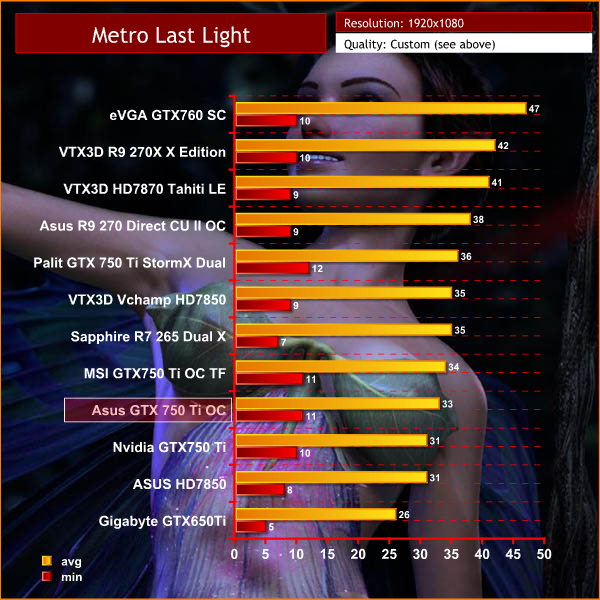Metro: Last Light takes place one year after the events of Metro 2033, proceeding from the ending where Artyom chose to call down the missile strike on the Dark Ones. The Rangers have since occupied the D6 military facility, with Artyom having become an official member of the group. Khan, the nomad mystic, arrives at D6 to inform Artyom and the Rangers that a single Dark One survived the missile strike.
4A Games’ proprietary 4A Engine is capable of rendering breathtaking vistas, such as those showing the ruined remnants of Moscow, as well as immersive indoor areas that play with light and shadow, creating hauntingly beautiful scenes akin to those from modern-day photos of Pripyat’s abandoned factories and schools.

We test this game with the built in benchmark with very high quality settings at 1920×1080 – details shown in the image above.

A demanding benchmark script, but the results are as we would expect, just ahead of the reference clocked solution.
 KitGuru KitGuru.net – Tech News | Hardware News | Hardware Reviews | IOS | Mobile | Gaming | Graphics Cards
KitGuru KitGuru.net – Tech News | Hardware News | Hardware Reviews | IOS | Mobile | Gaming | Graphics Cards



Good card, but yeah no need for a 6 pin power connector. my own MSI card sits at 1,200mhz and doesn’t need it.
ull need it if gets unlocked or u get a bios mod
Sure would have like to have a R7 260X represented, while the extra Higher end 270X up taken out just to not complicate things. Your B-M don’t paint that great of picture, largely due to the higher setting. It just isn’t realistic for that grouping of cards to expect advanced setting on 1920x. Would rather see adjusted settings that keep the 1980x average more in the 35-45Fps “playable” range. I mean to drop £131.99 [$180 USD] and only get entry level seem unimpressive, sure the power is low but IDK.
Here’s my thinking it’s nothing more than an “entry gaming” card that’s basically the reincarnation of the HD 5670 from 4 years ago. Same basic “plug-n-play” card that permits “medium” settings on (what was at that time) the mainstream 1680x resolution. Today that resolution is clearly 1080p, but now the price has jumped like 110%… that’s not progress, it’s just a 5670 for today… and today entry gaming has an exorbitant price!